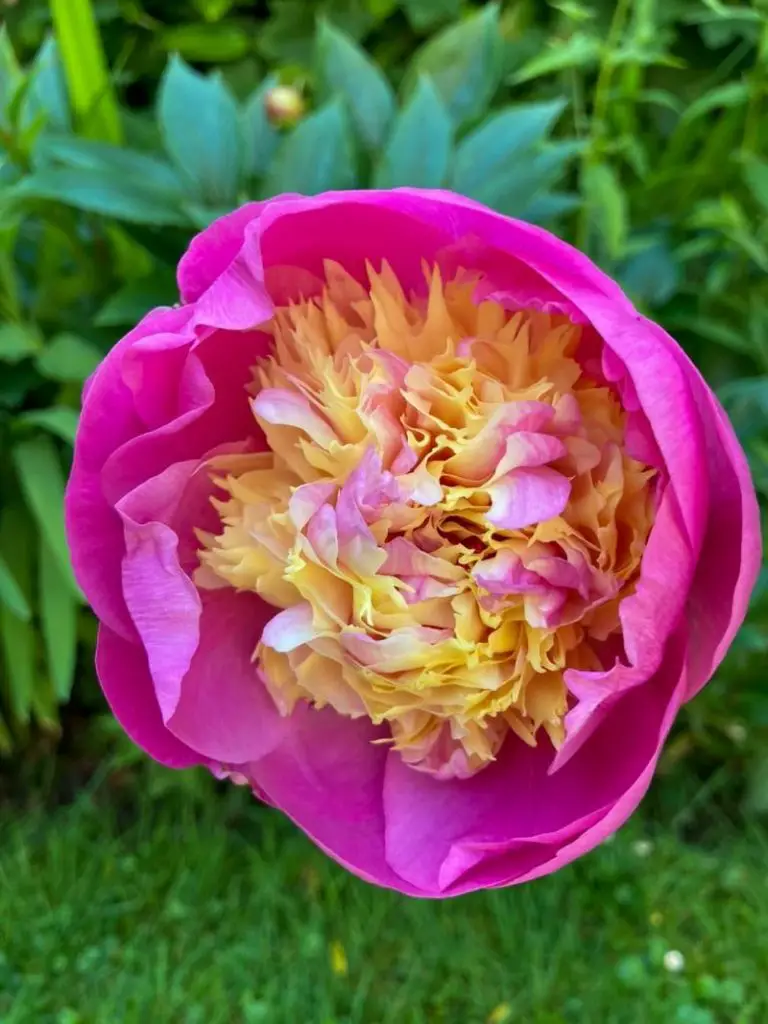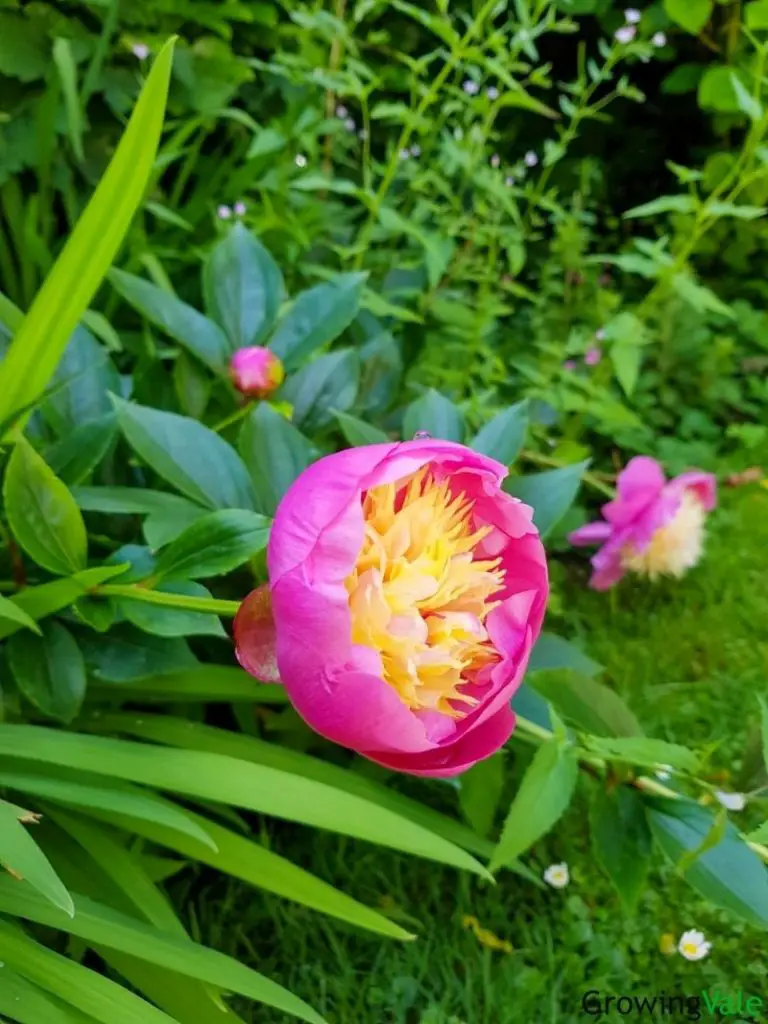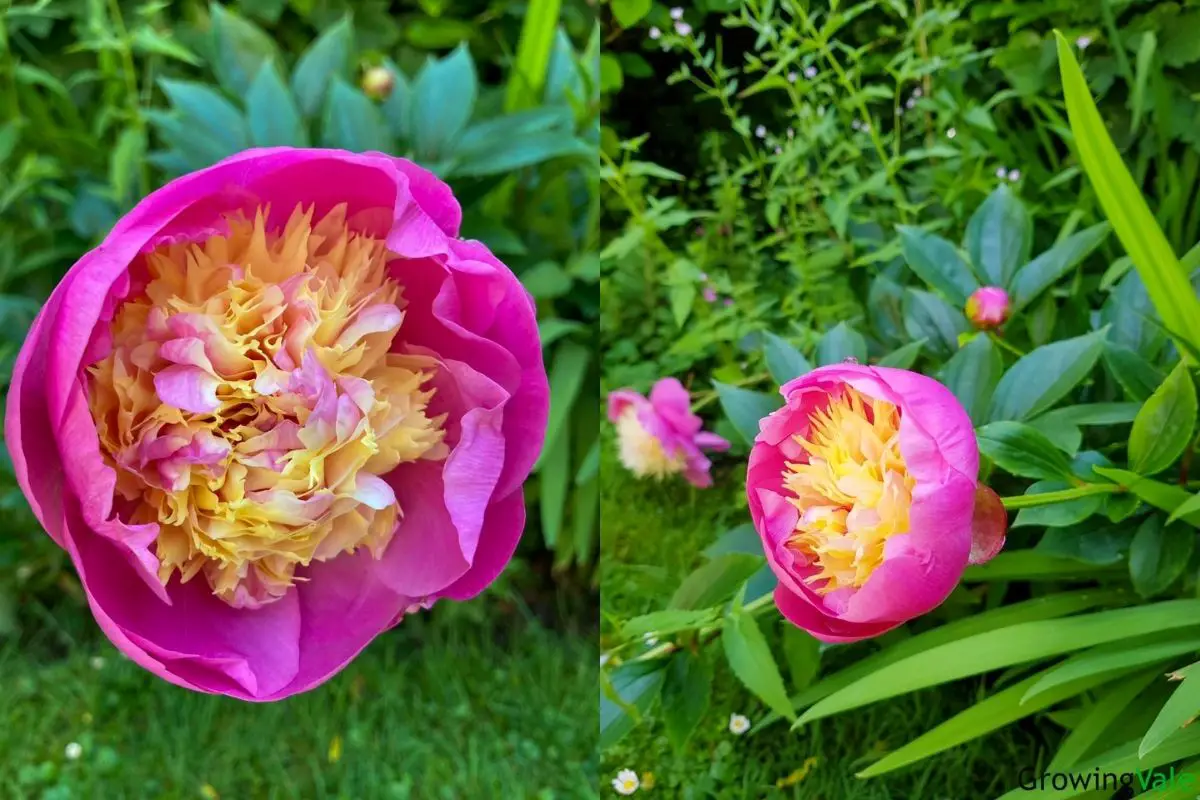Paeonia lactiflora, also known as The Chinese Peony, is a hardy perennial that blooms year after year. It is hugely popular among gardeners and comes in many attractive varieties.
These plants are low maintenance, long-living, and are beautiful in cottage-style gardens or sunny borders.
History
Chinese Peonies were first introduced into Europe in the 1800s from China, where they had been cultivated for over a millennium.
These plants bloom in late spring to early summer and have large, bowl-shaped flowers. Varieties come in a range of colors and have many forms such as single, semi-double, fully double, Japanese, bomb, and anemone.
Plant Facts
| Scientific name | Paeonia lactiflora |
| Common names | Chinese Peony, Herbaceous Peony, Garden Peony |
| Genus | Paeonia |
| Family | Paeoniaceae |
| Height | 1.ft 6 in. – 4ft. 0 in. |
| Width | 1ft. 6 in. – 4ft. 0 in. |
| USDA Plant Hardiness Zone | 3a, 3b, 4a, 4b, 5a, 5b, 6a, 6b, 7a, 7b, 8a, 8b |
| Origin | China |
| Flower colors | Red, Pink, Yellow, Orange, White, Cream |
| Blooming season | 7-10 days in late spring-early summer |
| Plant/Flower special features | Large, showy flowers |

How to Plant and Grow Chinese Peony Bulbs
Plant Chinese Peony bulbs in fall before the winter frost. They need to be in a sheltered site, but away from trees or large shrubs as they do not like competition.
Growing Chinese Peony Flowers in a Bed
Dig a hole twice as wide and as deep as the root ball. Place the bulb with its red-eye bud 1 inch below the soil. Water well until the plants are established and space them at least 3 feet apart.
Chinese Peony plants will benefit from extra support to stop their stems from bending. Stake and ring the plants when shoots are small to prevent any damage to new shoots.
Growing Chinese Peony Flowers in a Pot
These plants can also be grown in pots using the same recommendations as beds, but staking may be required. Use a well-drained container, and do not overwater as they are susceptible to root rot.

Propagation
Propagation by division is the most widely used method, but propagation from seed is possible.
Division
Divide Chinese Peonies in the fall after the foliage has been cut down to ground level. Plant the new divisions before the first frost so the roots can acclimate.
Lift the plant gently out of the ground keeping the root system intact. Remove any soil surrounding the roots to expose them and any new forming buds.
Divide the crown into sections with at least 3 new growth buds and some roots per section. Plant the sections into the ground with red-eyes 1 inch below the surface. Plants should flower 2 years after division.
Seeding
Collect your seeds from ripe seed pods in late summer to fall. Seeds may be black or red, discard any red seeds as these will not germinate.
Sow seeds 1 inch deep in a tray with seed compost and place in a cold frame or a sheltered spot outdoors. Keep the compost moist. It can take up to 5 years before they reach flowering size.

Care and Maintenance
Here are some important peony care tips:
Soil
Chinese Peonies prefer well-draining, fertile, and slightly acidic soil. Before planting them, amend the soil with well-rotted manure or compost. A small amount of bone meal can also be incorporated.
Water
Water these plants regularly during their first year, and after that, they will only require regular watering during dry spells.
Water the soil thoroughly to a depth of around 12-18 inches, allowing the soil to dry out fully in between waterings.
Fertilizer
Fertilize Chinese Peony flowers in spring and then again after flowering has finished. Use a general-purpose fertilizer at 20oz per square yard and apply around the crown of the plant.
Mulch with compost or well-rotted manure to suppress weeds and conserve moisture. Every few years, add a handful of bone meal around the plant and mix into the soil.
Sunlight
These plants need full sunlight, as those that are grown in shaded areas will produce fewer blooms.
Temperature and Humidity
Chinese Peonies are hardy to USDA zones 3-8 but need a cold period to bloom.
Pest and diseases
Chinese Peonies are generally disease-free but can get powdery mildew, Peony wilt, Peony blotch, and blight (Botrytis and Phytophthora). Peony wilt is serious, and if found, cut away infected parts and safely burn them.
They are prone to Thrips and ants. Ants may be annoying, but they won’t harm the plant. Remove leaves and stems infected with Thrips.
Pruning
Remove side buds found on stems to encourage bigger central blooms and prune away any spent flowers. To prevent Peony wilt disease, cut back foliage to the ground every fall.
Toxicity
Chinese Peony plants are mildly toxic to people and animals if ingested. Symptoms of poisoning include nausea, diarrhea, and vomiting.
Uses of the Chinese Peony
Chinese Peonies are hugely popular for bouquets as their blooms have a lovely fragrance.
They have been used for their medicinal purposes for over 1200 years in Eastern Asia. The remedy is made using the root of the plant and treats ailments such as rheumatoid arthritis, muscle cramping and spasms, and fevers.
Common Varieties and Cultivars
These plants have many beautiful forms and colors, and a careful selection of varieties can extend your blooming season by up to 6 weeks! Below is a list of popular cultivars with different bloom times:
- Paeonia “Athena” – very early-season
- Paeonia “Burma Ruby” – early season
- P. lactiflora “Miss America” – early mid-season
- P. lactiflora “Sea Shell” – mid-season
- P. lactiflora “Bowl of Beauty” – late mid-season
- P. lactiflora “Pink Parfait” – late-season
Also check our article for more types of peonies.
Conclusion
The Chinese Peony is a long-lived perennial that will bloom year after year. It is low-maintenance and easy to propagate, with delightful flowers that come in many forms and colors.
Cultivated in East Asia as far back as 1200 years ago, these plants are used as traditional remedies. Nowadays, they make excellent cut flowers and are hugely popular for bouquets.
*References
Reference list:
Dong-Yi He and Sheng-Ming Dai. (2011). Anti-Inflammatory and Immunomodulatory Effects of Paeonia Lactiflora Pall., a Traditional Chinese Herbal Medicine
https://www.ncbi.nlm.nih.gov/pmc/articles/PMC3108611/
K. Fackelmann. (1984). Peonies in Myth, Science, and Art,
https://agris.fao.org/agris-search/search.do?recordID=US8537415
”Close”

